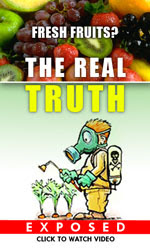March 4, 2013 | By admin | 6 Replies
 Ginger Garner, Guest Writer
Ginger Garner, Guest Writer
Waking Times
No one wants to hear the phrase "you are aging prematurely." However, that is exactly what is happening when you suffer from chronic disease.
The phrase "anti-inflammatory diet" is a huge buzzword now in medicine, fitness, and nutrition circles. But does it have any scientific support? Can we actually improve longevity through our nutritional and exercise habits?
The short answer is yes. Harvard trained physician and integrative medicine pioneer, Dr. Andrew Weil states, "It is becoming increasingly clear that chronic inflammation is the root cause of many serious illnesses – including heart disease, many cancers, and Alzheimer's disease." There is mounting evidence that foods and exercise can either cause or create inflammation in the body. Researchers and health care professionals alike report that most all modern diseases can be attributed to inflammation in the body.[1]
But how can we sort through the gimmick diets and mountains of supplements recommended to us by pop culture science? First, let's take a look at the science of inflammation in the body to understand why inflammation, even low grade levels of inflammation, can wreck your health.
The Science of Food-Induced Inflammation
Saturated Fat & Trans-Fatty Acids
"All foods fit into three categories: pro-inflammatory, neutral, or anti-inflammatory," says dermatologist and best-selling author, Nicholas Perricone, MD. Perricone says an anti-aging diet slows cellular aging, which depends on choosing foods that are anti-inflammatory and rich in antioxidants.
Dr. Alcock and colleagues, in a landmark study (Alcock et al 2012) on the role of dietary fats in inflammation, show through a comprehensive literature review of over 207 peer-reviewed medical studies, reported that "the body preferentially up-regulates inflammation in response to saturated fatty acids, which promotes harmful microbes." In short, the study found that saturated fat consumption immediately increases activity and presence of harmful and damaging gut bacteria, which are correlated with increased inflammatory response and expression of inflammatory genes. Saturated fats in general, induce inflammation by "activating nuclear transcription factors "(Schwartz et al 2010). The take home message is that a plant based diet, high in anti-oxidants, flavonoids, prebiotic, and probiotic function, can reduce our risk and even help us immediately manage inflammatory states in the body.
But that is not all. Saturated fats are not the only lurking inflammatory culprit of chronic disease.
Sugar & Starches
In addition to saturated fats and trans fatty acids, other foods which are inflammatory agents include:
- Sugar
High sugar diets lead to abnormal modulation of the gut microbiome. This essentially contributes to insulin sensitivity, inflammation, macrophage infiltration, and other dysregulation in blood chemical levels (Cani et al 2009) - Starches
High starch/carbohydrate diets (potatoes) causes insulin levels to surge and trigger an inflammatory response and accelerate the aging process," (Perricone).
- In a Nurse's Health Study (Mozaffarian et al 2011) that followed over 128,000 Americans over a 20 year period, the following specific foods were found to cause the most weight gain and in this order:
- Potatoes in all forms
- Sugar sweetened beverages
- Red meats
- Processed meats (deli meats)
- Trans fat
- Sweets/desserts
- Refined grains
- By contrast the same study found yogurt, whole fat milk, vegetables, whole grains, fruits, and nuts to be the least inflammatory.
- Other anti-inflammatory foods include red wine, green tea, dark chocolate, as well as many common vegetables like garlic, broccoli, onions, kale, and chile peppers. Berries (which the Environmental Working Group labels as one of the "Top 12 Dirty Dozen" produce which must be organic) are considered high in flavonoids and anti-inflammatory, anti-parasitic, anti-microbial, and anti-oxidant effects.
Learn more about what foods to include in an anti-inflammatory diet, which resembles a Mediterranean Diet, here.
 Exercise as an Anti-Aging Activity
Exercise as an Anti-Aging Activity
At the Centre of Inflammation and Metabolism, research supports the anti-inflammatory effects of exercise as well. "Regular exercise offers protection against all-cause mortality, primarily by protection against atherosclerosis and insulin resistance. There is also evidence that physical training is effective as a treatment in patients with chronic heart diseases and type-2 diabetes" via inducing anti-inflammatory actions (Pederson 2006). The study suggests that regular exercise induces suppression of inflammatory activity such as TNF-alpha (tumor necrosis factor-alpha) induced insulin resistance. Brandt and Pederson (2010) also report that regular exercise offers protection against type 2 diabetes, cardiovascular diseases, colon cancer, breast cancer, and dementia via "induction of an anti-inflammatory effect secondary to reduction of visceral fat mass" or by cellular and biochemical environmental changes in the exerciser.
When a person exercises, scientists posit that contracting skeletal muscles facilitate healthy neuroendocrine regulation. This means that exercise (like yoga or Tai Chi, for example) via contracting skeletal muscles release myokines that have an anti-inflammatory biochemical, or endocrine, effect. Further, changes in signaling pathways involved in "fat oxidation and glucose uptake" further increase the anti-inflammatory benefits of exercise. What this means is that exercise can have both local and global anti-inflammatory effects. For example, therapists or physicians working in orthopaedic medicine should consider the enormous implications that anti-inflammatory dietary counseling would have on improved patient outcomes. Personally, it means that even after a single inflammatory meal – your body is adversely affected on both a macro (whole body health) and micro (cellular and biochemical health) level. The good news is that a single anti-inflammatory meal or bout of exercise can result in immediate improvement in your systemic health.
Benefits of having healthy "anti-inflammatory" exercise and nutritional habits include: (Gonzales 2010, Jin 2010, Larrosaa et al 2010, Mamplekou et al 2010, Muller 2010, Pantsulaia et al 2010, Sticher et al 2010, Garcia-Lafuente et al 2009, Jurenka 2009, Tice et al 2003, McAlindon and Felson 1997):
- Decrease your risk for chronic diseases like heart disease, arthritis, diabetes, and dementia.
- Decrease your risk of cancers like breast, prostate, colon, and colorectal cancer
- Decrease your risk of neurodegenerative and autoimmune diseases
- Lose & maintain a healthy weight
- Improve lung/respiratory health
- Improve neurophysiological and psycho-emotional health (i.e. depression)
- Decrease allergies
- Stabilize blood sugar
Pursuit of longevity and enjoying a high quality and quantity of life depends on developing good anti-inflammatory lifestyle habits, especially for exercise and nutrition. In effect, the old cliché "you are what you eat," really is true.
About the Author
Ginger Garner MPT, ATC — is an educator and subject matter expert in medical therapeutic yoga and women's health. As a published author and sought after speaker, Ginger pens the popular blog for mothers — Breathing In This Life (BITL –which is one of the columns in Yang-Sheng magazine and network). Ginger is founder of Professional Yoga Therapy (PYT), the first education program for Complementary and Alternative Medicine practice in medical therapeutic yoga in the US. Ginger's focus is on education and activism for maternal and child health – through BITL, her school, PYT, through the organization she founded for Haiti relief in 2009, Musicians 4 Missions, and her work with the Initiative to Educate Afghan Women. Ginger has spoken and performed across the US to educate people about medical yoga and to raise awareness and funds for improving women's health. As a working mother of three she has learned a thing or two about finding work/life balance through the healing arts, which she shares through BITL, at www.gingergarner.com.
Sources:
- Aggarwal BB, Harikumar KM. Potential therapeutic effects of curcumin, the anti-inflammatory agent, against neurodegenerative, cardiovascular, pulmonary, metabolic, autoimmune and neoplastic diseases. Int J Biochem Cell Biol. 2009 Jan;41(1):40-59. Epub 2008 Jul 9.
- Aggarwal BB, Sundaram C, Malani N, Ichikawa H. Curcumin: The Indian solid gold. Adv. Exp. Med. Biol. 2007; 595: 1-75.
- Alcock J, Franklin ML, and Kuzawa CW. Nutrient Signaling: Evolutionary Origins of the Immune-Modulating Effects of Dietary Fat. The Quarterly Review of Biology. Vol 87, No. 3 September 2012. pp 187-223.
- Brandt C, Pedersen BK. The role of exercise-induced myokines in muscle homeostasis and the defense against chronic diseases. J Biomed Biotechnol. 2010;2010:520258. Epub 2010 Mar 9.
- Fantuzzi G. Aipose tissue, adipokines, and inflammation. J. Allergy Clin. Immunol. 2005; 115:911-915.García-Lafuente A, Guillamón E, Villares A, Rostagno M, Martínez J. Flavonoids as anti-inflammatory agents: implications in cancer and cardiovascular disease.Inflammation Research. Vol 58 (9); 2009-09-01: pp 537-552.González-Gallego J, García-Mediavilla MV, Sánchez-Campos S, Tuñón MJ. Fruit polyphenols, immunity and inflammation. Br J Nutr. Oct;104 Suppl 3:S15-27. 2010.Hsu A, Bray TM, Ho, E. Anti-inflammatory activity of soy and tea in prostate cancer prevention. Exp. Biol. Med. 2010 235: 659-667.Hyman, M. Is Your Body Burning Up With Inflammation? August 27, 2009. Article originally published in Huffington Post.Mathur N. Pedersen BK. Exercise as a means to control low-grade systemic inflammation. Mediators Inflamm. 2008:2008:1-6.
- Jin JH, Kim JS, Kang SS, Son KH, Chang HW, Kim H. Anti-inflammatory and anti-arthritic activity of total flavonoids of the roots of Sophora flavescens. J Ethnopharmacol. Feb 17;127(3):589-95. Epub 2009 Dec 23.2010.
- Jurenka JS. Anti-inflammatory properties of curcumin, a major constituent of Curcuma longa: a review of preclinical and clinical research. Alternative Medicine Review, 2009 June; 14(2): 141-53.
- Mamplekou, E, Bountziouka, V, Psaltopoulou, T, Zeimbekis, A, Tsakoundakis, N, Papaerakleous, N, Gotsis, E, Metallinos, G, Pounis, G, Polychronopoulos, E, Lionis, C, Panagiotakos, D. Urban environment, physical inactivity and unhealthy dietary habits correlate to depression among elderly living in eastern Mediterranean islands: The MEDIS (MEDiterranean ISlands elderly) study. The Journal of Nutrition, Health & Aging. Vol 14(6); 2010-06-01: 449- 455.
- McAlindon T, Felson DT. Nutrition: risk factors for osteoarthritis. Ann Rheum Dis 1997;56:397-400 doi:10.1136/ard.56.7.397Mueller M, Hobiger S, Jungbauer. Anti-Inflammatory Activity of extracts from fruit
- Mozaffarian et al 2010. Effects on coronary heart disease of increasing polyunsaturated fat in place of saturated fat: a systematic review and meta-analysis of randomized controlled trials. PLoS Medicine 7:31000252
- Pantsulaia I, Kalichman L, Kobyliansky E. Association between radiographic hand osteoarthritis and RANKL, OPG and inflammatory markers. Osteoarthritis and cartilage / OARS, Osteoarthritis Research Society 1 November 2010 (volume 18 issue 11 Pages 1448-1453 DOI: 10.1016/j.joca.2010.06.009)
- Pederson 2006. The Anti-Inflammatory Effect of Exercise. Essays Biochem. 2006;42:105-17.
- Pederson and Saltin 2006. Evidence for Prescribing Exercise as Therapy for Chronic Disease. Scandinavian Journal of Medicine & Science in Sports. Volume 16, Issue S1, pages 3–63, February 2006
- Peterson and Pederson 2006. The Role of IL-6 in Mediating the Anti-Inflammatory Effects of Exercise. Journal of physiology and pharmacology ISSN 0867-5910 2006, vol. 57, pp. 43-51, SUP10 [9 page(s) (article)]
- Schwartz et al 2010. Nutrient Modification of the innate immune response: a novel mechanism by which saturated fatty acids greatly amplify monocyte inflammation. Arteriosclerosis, Thrombosis, and Vascular Biology 30: 802-808.
- Stewart LK, Flynn MG, Campbell WW, et al. The influence of exercise training on inflammatory cytokines and C-reactive protein. Med. Sci Sports Exerc. 2007;39:1714-1719.
- Sticher MA, Smith CB, Davidson S. Reducing heart disease through the vegetarian diet using primary prevention. Journal of the American Academy of Nurse Practitioners. VL - 22, IS - 3, PB - Blackwell Publishing Ltd. 134-139. 2010. Tice JA, Browner W, Tracy RP,Cummings SR. The relation of C-reactive protein levels to total and cardiovascular mortality in older U.S. women. Am J Med. 2003 Feb 15;114(3):199-205.
- Tice JA, Browner W, Tracy RP, Cummings SR. The relation of C-reactive protein levels to total and cardiovascular mortality in older U.S. women. Am J Med. 2003 Feb 15;114(3):199-205.
- [1] Alcock et al 2012, Hsu 2010, González-Gallego et al 2010, Larrosaa et al 2010, Sticher et al 2010, Hyman 2009, Garcia-Lafuente et al 2009, Aggarwal and Harikumar 2008, Aggarwal et al 2007, Fantuzzi 2005, Pederson 2006, Pederson and Saltin 2006, Peterson and Pederson 2006, Stewart et al 2007.
This article is offered under Creative Commons license. It's okay to republish it anywhere as long as attribution bio is included and all links remain intact.













